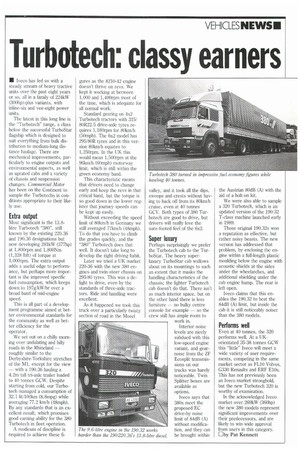Turbotech: classy earners
Page 13

If you've noticed an error in this article please click here to report it so we can fix it.
• Iveco has fed us with a steady stream of heavy tractive units over the past eight years or so, all in a family of 224kW (300hp)-plus variants, with inline-six and vee-eight power units.
The latest in this long line is the "Turbotech" range, a class below the successful TurboStar flagship which is designed to suit everything from bulk distribution to medium-long distance haulage. There are mechanical improvements, particularly to engine outputs and environmental aspects, as well as uprated cabs and a variety of chassis and suspension changes. Commercial Motor has been on the Continent to sample the Turbotechs in conditions appropriate to their likely use.
Extra output
Most significant is the 13.8litre Turbotech "380", still known by the existing 220.36 and 190.36 designations but now developing 281kW (377hp) at 1,800rpm and 1,800Nm (1,328 lbft) of torque at 1,000rpm. The extra output adds a useful edge to performance, but perhaps more important is the improved specific fuel consumption, which keeps down to 197g/kW/hr over a broad band of mid-engine speed.
This is all part of a development programme aimed at better environmental standards for the community as well as better efficiency for the operator.
We set out on a chilly morning over undulating and hilly roads in the Rhineland — roughly similar to the Derbyshire-Yorkshire stretches of the Ml, except for the view — with a 190.36 hauling a 4.2m tall tri-axle trailer loaded to 40 tonnes GCW. Despite starting from cold, our Turbotech managed a consumption of 32.1 lit/100km (8.8mpg) while averaging 77.2 km/h (48mph), By any standards that is an excellent result, which promises good earning ability for the 380 Turbotech in fleet operation.
A modicum of discipline is required to achieve these fi
gures as the 8210-42 engine doesn't thrive on revs. We kept it working at between 1,000 and 1,400rpm most of the time, which is adequate for all normal work.
Standard gearing on 4x2 Turbotech tractors with 315/ 80R22.5 drive-axle tyres requires 1,180rpm for 80kmili (50mph). The 6x2 model has 295/80R tyres and in this version 801an/h equates to 1,250rpm. In the UK this would mean 1,500rpm at the 961un/h (60mph) motorway limit, which is still within the green economy band.
This characteristic means that drivers need to change early and keep the revs in that critical band, but the torque is so good down in the lower register that journey speeds can be kept up easily.
Without exceeding the speed limit of 80km/h in Germany we still averaged 77knilh (48mph). To do that you have to climb the grades quickly, and the "380" Turbotech does that well. It doesn't take long to develop the right driving habit, Later we tried a UK market 220-36 with the new 380 engines and twin-steer chassis on 295/80 tyres. This was a delight to drive, even by the standards of three-axle tractors. Ride and handling were excellent.
As it happened we took this truck over a particularly twisty section of road in the Mosel valley, and it took all the dips, swoops and crests without having to back off from its 80km/h cruise, even at 40 tonnes GCV. Both types of 380 Turbotech are good to drive, but drivers will really love the sure-footed feel of the 6x2.
Super luxury
Perhaps surprisingly we prefer the Turbotech cab to the TurboStar. The heavy superluxury TurboStar cab wallows about on its mountings to such an extent that it masks the handling characteristics of the chassis; the lighter Turbotech cab doesn't do that. There isn't as much interior space, but on the other hand there is less furniture — no bulky centre console for example — so the crew still has ample room to work in.
Interior noise levels are nicely subdued with this low-speed engine variant, and gearnoise from the ZF Ecosplit transmissions on our trucks was barely noticeable. Twin Splitter boxes are available as options.
Iveco says that 380s meet the proposed EC drive-by noise limit of 84dB (A) without modification, and they can be brought within the Austrian 80dB (A) with the aid of a bolt-on kit.
We were also able to sample a 320 Turbotech, which is an updated version of the 190-32 T-class machine launched early in 1989.
Those original 190.32s won a reputation as effective, but rather noisy beasts. The new version has addressed that problem, by enclosing the engine within a full-length plastic moulding below the engine with acoustic shields at the sides under the wheelarches, and additional shielding under the cab engine hump. The rear is left open.
Iveco claims that this enables the 190.32 to beat the 84dB (A) limit, but inside the cab it is still noticeably noiser than the 380 models.
Performs well
Even at 40 tonnes, the 320 performs well. At a UKorientated 35-38 tonnes GCW this "little" Iveco will meet a wide variety of user requirements, competing in the same market sector as FL10 Volvos, G330 Renaults and ERF ElOs. This has not previously been an Iveco market stronghold, but the new Turbotech 320 is worthy of examination.
In the acknowledged Iveco market over 269kW (360hp) the new 380 models represent significant improvements over their predecessors, and are likely to win wide approval from users in this category. Oby Pat Kennett




































































































